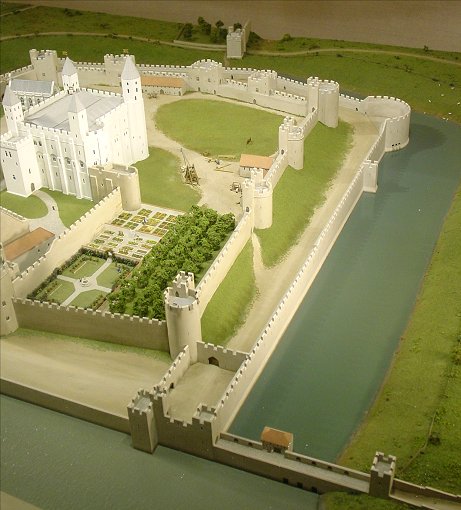
1335 Diorama
It is thought that defenses existed where the Tower of London sits for many
centuries, perhaps even into
prehistoric times. The Romans constructed walls around London, and these can be
seen at the top of the diorama. When William the Duke of Normandy conquered England
in 1066 he
immediately began a castle building program in order to maintain control of the
country. The Tower of London was a major part of this program, being
designed to protect and control the City of London and to serve as a royal
palace. The original building was the massive whitewashed White Tower
which tied in with the old Roman walls. It gave the facility its name, and
it still dominates the facility. A small wall encircled the Tower and
descended the small hill to the River Thames. By 1200, the southern
portion of the current inner wall, which was then on the waterfront, and half of
the eastern inner wall had been built. By 1270 the whole of the modern
inner wall was completed along with a surrounding moat. By the early 1300s this
moat had been filled in and the river had been reclaimed for an additional outer
wall fronted by a new moat. Outworks protected the southwest entrance from
the city. The Tower
was now one of the most formidable castles in Europe. Perhaps to
compensate for the many sins of kingship, the Chapel of St. Peter ad Vincula was
in the northwest corner of the inner ward. Already home of the royal
menagerie, the Tower was soon used as a records store and home of the mint.

What is now called Traitor's Gate extended into the Thames to provide an entrance and exit on the Thames.

As you can see, the southwestern entrance from the city was truly impressive. Of course in the highly unlikely event that all of these defenses were taken, the massive White Tower would still remain.

This is the eastern side of the facility. You can see that the White Tower is on a hill and that there is a slope between the two outer walls. By design, the inner of the two walls dominates the outer.
The diorama's caption reads,
"This model shows the Tower of London as it might have looked in about 1335, following the completion of the strengthening and enlargement begun by Edward I (1272-1307) in the 1270s.
The reconstruction is based on recent historical and archeological research. Before Edward's reign the castle consisted of the White Tower (late 11th - 12th century), a bailey (an enclosure) to the south, all surrounded by the massive towered curtain wall built by Edward's father, Henry III (1216-1272) in the 1240s. Edward added the outer curtain wall and moat as shown, together with the complex and strongly defended south-western entrance.
Almost all of this survives today in a modified form. As completed, with its wide moat and double circuit of wall, Edward's castle was among the strongest and most impressive in Europe, equipped to serve as a symbol of royal power and a place of refuge for the king during times of danger."
Return to Tower of London Index